|
Ancient Jewelry
|
|
 |
|
 |
|

Price :
$2400.00
Origin: Jerusalem
Circa: 307 AD to 337 BC
Collection: Coin Jewelry
Style: Roman
Medium: Bronze, Gold
Origin: Jerusalem
Circa: 307 AD to 337 BC
Collection: Coin Jewelry
Style: Roman
Medium: Bronze, Gold « Less
|
|
Ancient Jewelry
|
|
|
|
|
| Vendor Details |
Close |
| Contact Info : |
| Barakat Gallery |
| 405 North Rodeo Drive |
| Beverly Hills |
| California-90210 |
| USA |
| Email : barakat@barakatgallery.com |
| Phone : 310.859.8408 |
|
|
|
|
|
|
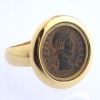
Price :
$1800.00
Origin: Jerusalem
Circa: 337 AD to 361 AD
Collection: Coin Jewelry
Style: Roman Coin Ring
Medium: Bronze, Gold
Additional Information: This Genuine Ancient Coin Has Been More »
Origin: Jerusalem
Circa: 337 AD to 361 AD
Collection: Coin Jewelry
Style: Roman Coin Ring
Medium: Bronze, Gold
Additional Information: This Genuine Ancient Coin Has Been Set in a Modern 18 karat Gold Ring « Less
|
|
Ancient Jewelry
|
|
|
|
|
| Vendor Details |
Close |
| Contact Info : |
| Barakat Gallery |
| 405 North Rodeo Drive |
| Beverly Hills |
| California-90210 |
| USA |
| Email : barakat@barakatgallery.com |
| Phone : 310.859.8408 |
|
|
|
|
|
|
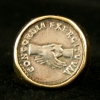
Price :
$3700.00
Origin: Israel
Circa: 96 AD to 98 AD
Collection: Coin Jewelry
Style: Roman Coin Rings
Medium: Silver and Gold
This genuine Ancient Roman coin has been mounted in a More »
Origin: Israel
Circa: 96 AD to 98 AD
Collection: Coin Jewelry
Style: Roman Coin Rings
Medium: Silver and Gold
This genuine Ancient Roman coin has been mounted in a modern 18 karat gold ring. - (FJ.5811) « Less
|
|
Ancient Jewelry
|
|
|
|
|
| Vendor Details |
Close |
| Contact Info : |
| Barakat Gallery |
| 405 North Rodeo Drive |
| Beverly Hills |
| California-90210 |
| USA |
| Email : barakat@barakatgallery.com |
| Phone : 310.859.8408 |
|
|
|
|
|
|
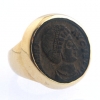
Price :
$2800.00
Origin: Jerusalem
Circa: 307 AD to 337 AD
Collection: Coin Jewelry
Style: Roman
Medium: Bronze, Gold
A remarkable woman, Helena was a persuasive influence at the court More »
Origin: Jerusalem
Circa: 307 AD to 337 AD
Collection: Coin Jewelry
Style: Roman
Medium: Bronze, Gold
A remarkable woman, Helena was a persuasive influence at the court of her son Constantine. She made a pilgrimage to Jerusalem in search of the true cross, and is revered as a saint by the Christian Church. Flavia Iulia Helena, also known as Saint Helena, Saint Helen, Helena Augusta, and Helena of Constantinople, (c.248 – c.329) was consort of (though may have been married to) Constantius Chlorus, and the mother of Emperor Constantine I. She is traditionally credited with finding the relics of the True Cross. Many legends surround her. She was allegedly the daughter of an innkeeper. Her son Constantine renamed the city of Drepanum on the Gulf of Nicomedia as 'Helenopolis' in her honour, which led to later interpretations that Drepanum was her birthplace. Constantius Chlorus divorced her (c.292) to marry the step-daughter of Maximian, Flavia Maximiana Theodora. Helena's son, Constantine, became emperor of the Roman Empire, and following his elevation she became a presence at the imperial court, and received the title Augusta. [edit] Sainthood She is considered by the Orthodox and Catholic churches as a saint, famed for her piety. Her feast day as a saint of the Orthodox Christian Church is celebrated with her son on May 21, the Feast of the Holy Great Sovereigns Constantine and Helen, Equal to the Apostles[1]. Her feast day in the Roman Catholic Church falls on August 18. Eusebius records the details of her pilgrimage to Palestine and other eastern provinces (though not her discovery of the True Cross)). She is the patron saint of archaeologists. At the age of 80, Helena was said by some accounts to have been placed in charge of a mission to gather Christian relics, by her son Emperor Constantine I, who had recently declared Rome as a Christian city. Helena travelled the 1400-plus miles from Rome to Jerusalem. The city was still rebuilding from the destruction of Hadrian, a previous emperor, who had built a Temple to Venus at the site of the Crucifixion. According to legend, Helena entered the temple with Bishop Macarius, and chose a site to begin excavating, which led to the recovery of three different crosses and the nails of the crucifixion. To use their miraculous power to aid her son, Helena allegedly had one placed in Constantine's helmet, and another in the bridle of his horse. Helena left Jerusalem in 327 to return to Rome, and shortly after her journey to the East Helena died in the presence of her son Constantine (Euseb., VC, 3.46). Some of the relics which she had located were then stored in her palace in Rome, which was later converted into the Abbey of Santa Croce. - (FJ.6013) « Less
|
|
Ancient Jewelry
|
|
|
|
|
| Vendor Details |
Close |
| Contact Info : |
| Barakat Gallery |
| 405 North Rodeo Drive |
| Beverly Hills |
| California-90210 |
| USA |
| Email : barakat@barakatgallery.com |
| Phone : 310.859.8408 |
|
|
|
|
|
|
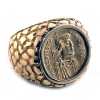
Price :
$4600.00
Origin: Israel
Circa: 641 AD to 68 BC
Collection: Byzantine Gold Coin Rings
Medium: Gold
As was the case with many emperors Constans II had to deal with invasions and More »
Origin: Israel
Circa: 641 AD to 68 BC
Collection: Byzantine Gold Coin Rings
Medium: Gold
As was the case with many emperors Constans II had to deal with invasions and incursions on many of the empires frontiers. By the age of eleven he was made coemperor, and spent his youth amidst court intrigue and wars. Though Egypt was lost to the Byzantines in A.D.642, Constans achieved considerable success against the Slavs in A.D.658. Towards the end of his reign he look the unprecedented step of removing his residence to the West. Making slow progess through the provinces, he finally settled in Syracuse where he established his imperial capital. This beautiful gold coin shows Constans facing right wearing diadem and cuirass. On the reverse is the cross potent on a globe with the surrounding legend VICTORIA AVGUS. This luminous coin is quite rare, just as the person who chooses to wear something so unique. - (FJ.6306) « Less
|
|
Ancient Jewelry
|
|
|
|
|
| Vendor Details |
Close |
| Contact Info : |
| Barakat Gallery |
| 405 North Rodeo Drive |
| Beverly Hills |
| California-90210 |
| USA |
| Email : barakat@barakatgallery.com |
| Phone : 310.859.8408 |
|
|
|
|
|
|
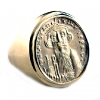
Price :
$2400.00
Origin: Israel (Jerusalem)
Circa: 641 AD to 48 BC
Collection: Coin Jewelry
Style: Byzantine
Medium: Gold
Constans II was barn to the purple as the son of the emperor More »
Origin: Israel (Jerusalem)
Circa: 641 AD to 48 BC
Collection: Coin Jewelry
Style: Byzantine
Medium: Gold
Constans II was barn to the purple as the son of the emperor Heraclius Constantine, having been made co-emperor at the age of eleven. During his reign the Arabs continued their victorious advance into Byzantine territory, subjugating the rich province of Egypt by 642. Constans strengthened his position by proclaiming his son, Constantine IV, Pogonatus, as co-emperor. Towards the end of his reign Constans took the extraordinary step of leaving Constantinople, slowly traveling through the western provinces until he finally settled in Syracuse. This very handsome gold coin shows the emperor facing forward with a long beard and moustache, wearing crown and chlamys (cloak), holding a globe with cross. On the reverse is the cross patent on three steps. The gleaming gold of this coin still reflects the glory that was once the great Byzantine Empire. - (FJ.6392) « Less
|
|
Ancient Jewelry
|
|
|
|
|
| Vendor Details |
Close |
| Contact Info : |
| Barakat Gallery |
| 405 North Rodeo Drive |
| Beverly Hills |
| California-90210 |
| USA |
| Email : barakat@barakatgallery.com |
| Phone : 310.859.8408 |
|
|
|
|
|
|
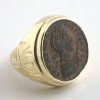
Price :
$3800.00
Origin: Jerusalem
Circa: 379 AD to 395 AD
Collection: Coin Jewelry
Style: Roman
Medium: Bronze, Gold
Theodosius' entrance onto the Roman stage marked the beginning of More »
Origin: Jerusalem
Circa: 379 AD to 395 AD
Collection: Coin Jewelry
Style: Roman
Medium: Bronze, Gold
Theodosius' entrance onto the Roman stage marked the beginning of formal division of the empire into _east and west parts. Having proven himself a superlative military commander, he was appointed magister militum by Emperor Gratian in 378 A.D. to repel the Goths. After long fighting he signed a treaty with them, and later with Persia thus establishing relative peace in the east. In 394 A.D. he defeated the western usurper Eugenius, which effectively left Theodosius in control of the entire empire. Only five months later he died of dropsy in Milan, leaving his sons Arcadius and Honorius to rule in the east and west respectively. A highly religious man, Theodosius initiated changes in the relationship between Church and State, and through his firm control left the empire more secure. On this fine coin Theodosius faces right wearing a helmet and cuirass, and on the reverse he is depicted standing on a galley turning to look at a figure of Victory at the helm. - (FJ.6519) « Less
|
|
Ancient Jewelry
|
|
|
|
|
| Vendor Details |
Close |
| Contact Info : |
| Barakat Gallery |
| 405 North Rodeo Drive |
| Beverly Hills |
| California-90210 |
| USA |
| Email : barakat@barakatgallery.com |
| Phone : 310.859.8408 |
|
|
|
|
|
|

Price :
$3800.00
Origin: Mediterranean
Circa: 117 AD to 138 AD
Collection: Jewelry
Style: Roman Coin Ring
Medium: Silver and Gold
Hadrian spent much of his reign traveling about the More »
Origin: Mediterranean
Circa: 117 AD to 138 AD
Collection: Jewelry
Style: Roman Coin Ring
Medium: Silver and Gold
Hadrian spent much of his reign traveling about the Roman Empire and checking into the well - being of the cities, towns, provinces, and ordinary citizens over whom he ruled. He was always interested in civic improvements, and would often have a new bridge, road, aqueduct, or temple built when he thought that the local citizens would benefit by such new construction. The reign of Hadrian at the height of the PAX ROMANA period was a time of great peace and prosperity in the Roman Empire. He continued the public works building projects that his adoptive father Trajan began and strengthened the defenses on the borders of the empire. Because of attacks on Roman citizens living in southern Britain, he built Hadrian's Wall across a narrow part of the island. Hadrian was an educated emperor and a patron of the arts. He spent most of his reign visiting the different provinces of the empire and personally overseeing the improvements and public works carried out under his orders. Like Trajan and Nerva before him, he adopted a grown man in order to make him heir to the throne. When his first adopted son Aelius Caesar died of illness, Hadrian adopted another, Antoninus Pius, who would succeed him when Hadrian died in his bed after a long illness.The natural splendor of the precious metals is allowed to shine in this ring. The natural hues of the silver and the gold complement each other. In this ring, the present and the past combine. The classic reserved form of the modern ring enhances the timeless beauty and majesty of the ancient coin. To wear this ring is to reconnect with the past while simultaneously exhibiting style and elegance that is contemporary and yet timeless. - (FJ.6738) « Less
|
|
Ancient Jewelry
|
|
|
|
|
| Vendor Details |
Close |
| Contact Info : |
| Barakat Gallery |
| 405 North Rodeo Drive |
| Beverly Hills |
| California-90210 |
| USA |
| Email : barakat@barakatgallery.com |
| Phone : 310.859.8408 |
|
|
|
|
|
|

Price :
$3300.00
Origin: Mediterranean
Circa: 136 AD
Collection: Coin Jewelry
Style: Roman
Medium: Silver, Gold
Antoninus Pius is regarded as one of the "Five Good Emperors" in history More »
Origin: Mediterranean
Circa: 136 AD
Collection: Coin Jewelry
Style: Roman
Medium: Silver, Gold
Antoninus Pius is regarded as one of the "Five Good Emperors" in history of Rome. He was born in 86 A.D. Around 133-136, he served in Asia as proconsul, and there he earned the respect of Emperor Hadrian. After Hadrian's return from the Jewish war, Antoninus was made a member of his council not only on grounds of friendships and family connection, but also because of his experience as a jurist and administrator. After the sudden death of Lucius Aelius Caesar, Antoninus was officially adopted by Hadrian on February 25, 138 as successor to the throne. After administering the imperial offices, Hadrian died and Antoninus became emperor. Antoninus married Faustina and they had four children: two sons and two daughters. However, only one daughter was alive at the time of his adoption by Hadrian. Later, he adopted Marcus Aurelius, who was to be the successor to his throne. In 139, he gave to Marcus the name of Caesar and made him consul designate. In 146, Aurelius was recognized as Antoninus's colleague in rule, and the hopes of Rome and the fortunes of the dynasty rested upon him. Antoninus managed to govern the empire capably and yet with such a gentle hand that he earned the respect, acclaim, and love of his subjects.The splendor of the precious metals is allowed to shine in this ring. The natural hues of the silver and gold complement each other. In this ring, the present and the past combine. The classical reserved form of the modern ring enhances the timeless beauty and majesty of the ancient coin. To wear this ring is to reconnect with the past while continuing to look stylish in the present. - (FJ.6793) « Less
|
|
Ancient Jewelry
|
|
|
|
|
| Vendor Details |
Close |
| Contact Info : |
| Barakat Gallery |
| 405 North Rodeo Drive |
| Beverly Hills |
| California-90210 |
| USA |
| Email : barakat@barakatgallery.com |
| Phone : 310.859.8408 |
|
|
|
|
|
|

Price :
$2500.00
Origin: Mediterranean
Circa: 306 BC to 337 BC
Collection: Coin Rings
Style: Roman Coin Ring
Medium: Bronze-Gold
Constantine I, called Constantine the Great, was the More »
Origin: Mediterranean
Circa: 306 BC to 337 BC
Collection: Coin Rings
Style: Roman Coin Ring
Medium: Bronze-Gold
Constantine I, called Constantine the Great, was the first Roman ruler to be converted to Christianity. He was the founder of Constantinople (present-day Istanbul), which remained the capital of the Eastern Roman (Byzantine) Empire until 1453. Constantine the Great unified a tottering empire, reorganized the Roman state, and set the stage for the final victory of Christianity at the end of the 4th century. Many modern scholars accept the sincerity of his religious conviction. His conversion was a gradual process; at first he probably associated Christ with the victorious sun god. By the time of the Council of Nicaea (325), however, he was completely Christian, but still tolerated paganism among his subjects. Although criticized by his enemies as a proponent of a crude and false religion, Constantine the Great strengthened the Roman Empire and ensured its survival in the East. As the first emperor to rule in the name of Christ, he was a major figure in the foundation of medieval Christian Europe.This stunning ring evokes the glory and beauty of the early Christian era and its flowering. The dark green hue of the tarnished bronze is striking when contrasted to the luminosity of the gold mounting. The course of Europe and the world would forever change due to the efforts of Constantine the Great. There is an eternal splendor to this ring, a beauty that radiates from within the coin and envelopes the gold setting. To wear this ring is to evoke the spirit of change. For although time changes and worlds evolve, true beauty and elegance as defined by this ring are eternal and immune to the fancies and whims of individual tastes. - (FJ.6608) « Less
|
|
Ancient Jewelry
|
|
|
|
|
| Vendor Details |
Close |
| Contact Info : |
| Barakat Gallery |
| 405 North Rodeo Drive |
| Beverly Hills |
| California-90210 |
| USA |
| Email : barakat@barakatgallery.com |
| Phone : 310.859.8408 |
|
|
|
|
|
|
|
|

|


